6 minutes
The differences between the responses of men and women may surprise you.
There are forces at play keeping your organization from reaching its peak effectiveness. These forces have roots deeper than your previous CEO’s leadership style and are more profound than any strategic decision your leadership team has made in the organization’s history. These forces, as powerful as they are, cannot simply be changed by a stroke of the pen or an act of Congress.
Female and male credit union leaders have different perspectives on power and influence within their organizations. The gender-specific responses to these variables vary so much that they impact their perception of their access to resources, career advancement, impact on the organization and engagement. And as the adage goes, “Perception is reality.”
The data from a survey from CUESolutions provider and Advancing Women sponsor DDJ Myers that I’ll present in this article should cause all of us to straighten in our chairs and dive deeper into what’s going on—both in general and in our particular organizations. Please let go of preconceived notions, biases or, dare I say, political platforms. This is not that. These are your peers and even your executives speaking to you. Please, take a moment and listen.
About the Survey
It is important to note that libraries are full of gender-based research that credit union leaders can garner important insights from. The research I’ll describe here is based on nine recent DDJ Myers credit union clients, averaging $1.3 billion in assets, making up a total population of 251 executive- to mid-level talent respondents. These 143 self-identified women and 108 men responded to a variety of statements using an agreement-based Likert scale as part of DDJ Myers’ Organization Alignment Assessment, an instrument that is a part of our strategy development, CEO succession and search, and executive-level training programs. Although providing insight into how various genders perceive and contribute to the organization is not the primary way our clients make use of this instrument, it is an important lens by which to broaden our leadership perspective.
The purpose of this article is to widen the view through which credit union leaders perceive gender-based dynamics and make decisions within their organizations. The data reveal a statistically significant variance in gender-based responses. As you take in the data, ask yourself these questions:
- What are the data revealing that I didn’t already know?
- What has been the long-term impact hereto of these perceptions?
- How might these phenomena show up today?
- What would have to happen to shift these perceptions?
- What could be the impact if they did?
- What is, or has been, my accountability to this dynamic?
Eight Measures to Consider
For your analysis, here are eight key measurements and the participants’ responses.
Measurement 1: To do my job the best I can, I engage in empowerment and autonomy conversations with my manager(s) when necessary.
Less than 2% of men feel that they somewhat to strongly disagree with engaging in empowerment and autonomy conversations with their managers when necessary. Four times as many women, 8%, feel that way.
Eleven percent more men than women strongly agree that they engage in these conversations.
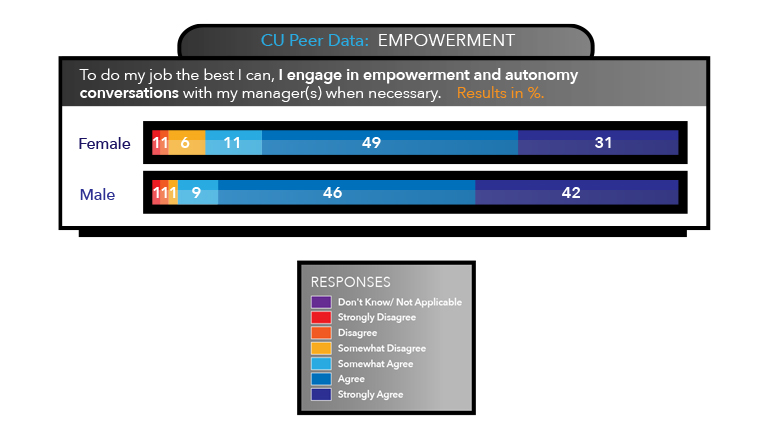
Measurement 2: My current role, exposure and access inside the organization is a point on my professional development path.
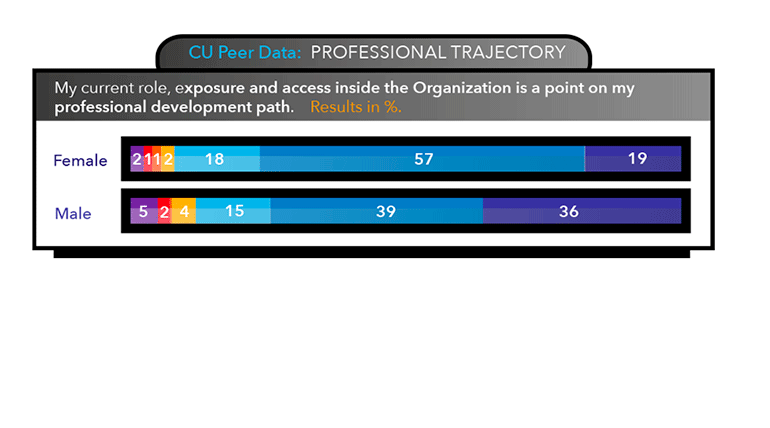
36% of men strongly agree that their role, exposure and access inside their organization is a point on their professional development path.
Less than a fifth of women strongly agree with that.
Measurement 3: The organization structures empowerment and autonomy appropriately so we can do what we need to do.
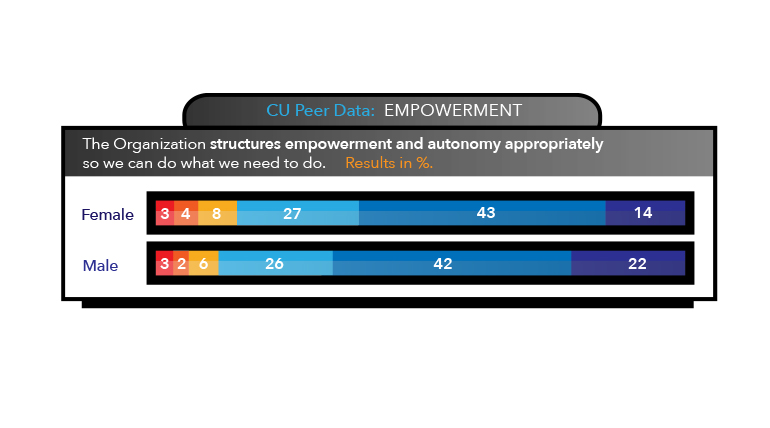
Compared to women, 8% more men strongly agree that the organization structures empowerment appropriately.
Only 10% of men somewhat to strongly disagree, compared to 16% of women.
Measurement 4: I am appropriately in the know about forthcoming changes that will affect me and my area.
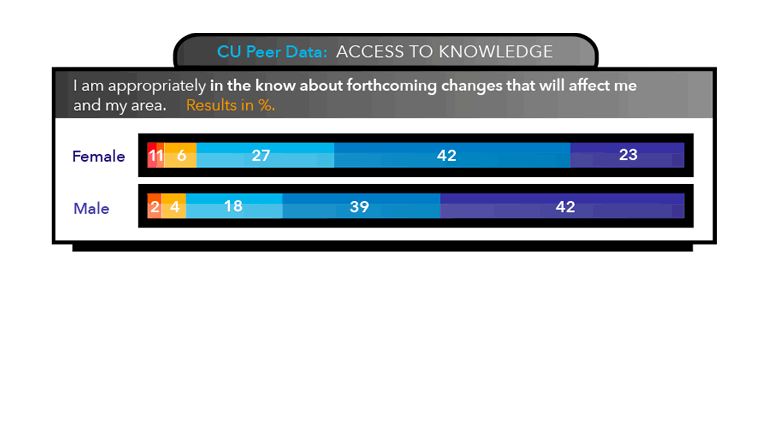
Less than a fourth of women strongly agree that they are “in the know” about forthcoming changes that will affect them and their areas.
Forty-two percent of men strongly agree that they are “in the know.”
Measurement 5: In general, senior leaders are accessible for conversations.
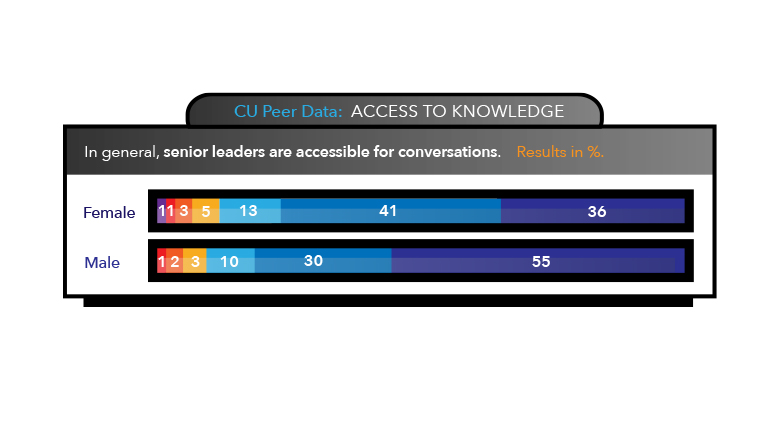
Just over a third of women strongly agree that senior leaders are accessible, and more than half of men feel the same.
Nine percent of women disagree in some regard, as compared to 5.5% of men.
Measurement 6: The organization allocates resources in a way that supports our short- and long-term priorities.
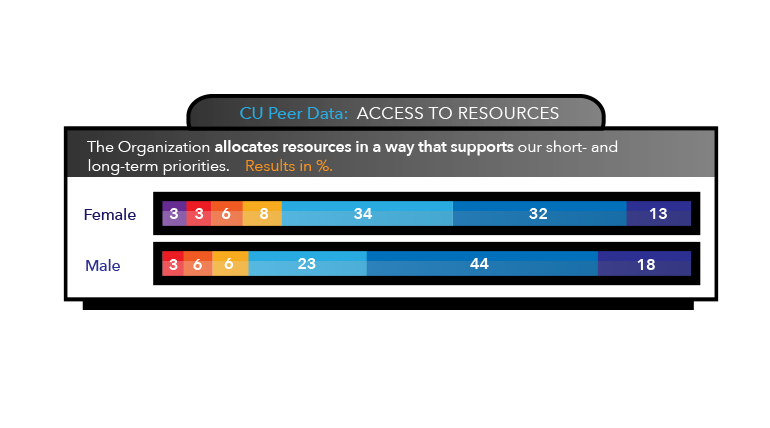
Forty-five percent of women strongly agree or agree that their organization allocates resources in a way that supports our priorities, and 62% of men feel the same way.
Measurement 7: Overall, I consider myself an actively engaged and committed employee.
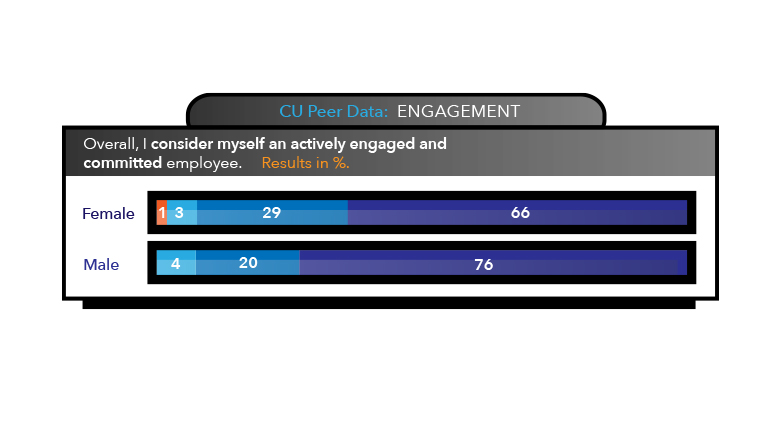
Ten percent more of men strongly agree, considering themselves to be an active and engaged employee.
Measurement 8: It is clear to me how my role and contributions add significant value to the organization.
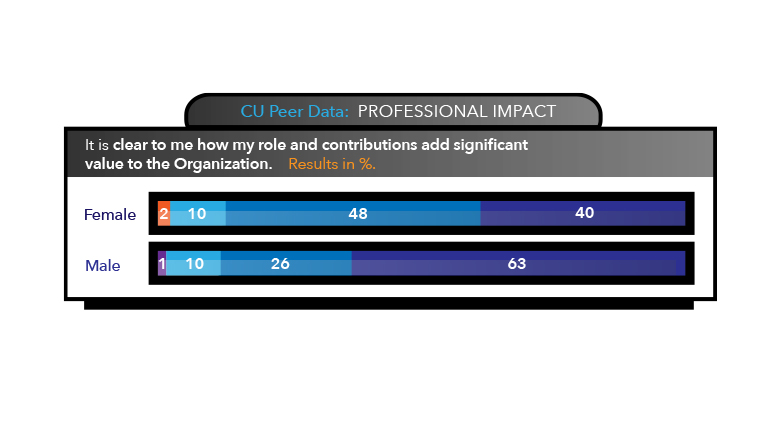
Twenty-three percent more men, as compared to women, strongly agree that they feel it is clear that their roles and contributions add significant value to the organization.
Two percent of women disagree with the statement, as compared to none of the men.
What the Gender-Based Data Mean
Now, let’s be clear that this is just survey data. However, we do feel an obligation to punctuate how we see the dynamics of these data play out inside of credit unions with a couple of anecdotal, yet telling, examples:
- A director of a credit union (not a client of ours) at a conference once said to me (and I’ll never forget it), “Hiring a woman for a CEO still seems like a risky business decision.” You might imagine that this event was from the 1950s, but it was Dec. 4, 2018.
- A male manager once told his female CEO that he felt he deserved to be a vice president. After a few rounds of questions from her as to why he felt he deserved to be a VP, he said, “Because I’m a man.” She was momentarily speechless.
As mentioned above, this is a complex dynamic, and it will not be right-sized with one action. Whether access and empowerment are measurably different inside your organization or not is not the point. The point is that there is a measurable difference in that perception and that it leaves untapped potential on the table. We build a psychological distinction into the curriculum of our leadership programs called self-clarity, which is our ability to see and accept ourselves as we are. Consider what this revelation could do: “Oh, I have more access/growth potential/impact than I perceive.”
Helping leaders see how they engage with the world empowers them to make a change. It’s a powerful and sustainable approach to developing the next generation of leaders and champions.
Peter Myers is SVP of CUESolutions provider and Advancing Women sponsor DDJ Myers, an ALM First company. DDJ Myers has been working with credit unions in a professional development capacity since 1989. The company has won awards for our innovative and impactful work across the country with organizations of all shapes and sizes. As part of its CEO succession planning process, executive search work, or strategy development and deployment programs, DDJ Myers deploys its organization alignment assessment, an instrument that provides stakeholders actionable insights about the organization’s strategic alignment and optimal readiness for future actions. The OAA has collected thousands of responses, so the data can now be considered across a variety of factors, including organization level, departments, tenure, race/ethnicity, and gender.










